If, when it comes to stadiums, you are a “sad-o” (that’s my wife’s term, I prefer aficionado), then you are inevitably drawn to the weird and unusual. Why settle for the staid and practical, when you can have illogical and unconventional? Over its four incarnations, The Riazor has provided the paying public of La Coruña and beyond with plenty of the weird and unusual. So much so that when the Riazor’s present form was unveiled in 1998, some home fans rioted and tore out seats. It was probably too conformist for them.

Real Club Deportivo La Coruña was formed on 2 March 1906 by members of the Sala Calvet gymnasium. They played briefly at the local bullring, before settling at El Corralón de la Gaiteira. This compact enclosure was surrounded by a tobacco factory and the club continued to play there for until May 1909. Depor then moved to the Parque de Riazor, a slightly larger site on an outcrop of rocks, next the Playa de Riazor. With the help of the municipality, basic facilities including a small covered stand and terracing were added. At the southern end of the ground stood a three-storey clubhouse, which in addition to changing facilities, also featured viewing balconies. The Parque de Riazor was actually closer to the coastline than the present stadium and served the club for 35 years. It saw top-flight football for just over three seasons when Depor was promoted to La Primera for the first time in 1941. It staged its final match on 8 October 1944, when Depor drew 2-2 with Real Madrid.
The Parque de Riazor made way for the Estadio de Riazor. This new stadium was built by the municipality 150 metres across the road from the old stadium at a cost of 5 million pesetas. Designed by architect Santiago Rey Pedreira and inspired by the German & Italian stadiums of the 1930s, it featured a low cantilevered stand on the northern side of the enclosure. At the west end was a semi-circular terrace that was built beneath the stadium’s prominent feature, a 45 metre-high marathon tower. The terracing continued around to the south side, where an additional upper tier of terracing stood. At the eastern seaboard end, instead of terracing, stood a row of arches leading to a practice pitch. An athletics track surrounded the pitch and Riazor was to become one of the leading venues for athletics on the Iberian Peninsula. Officially opened on 28 October 1944, Depor had to wait 24 hours before playing their first match at the new ground, a 2-3 defeat to Valencia.
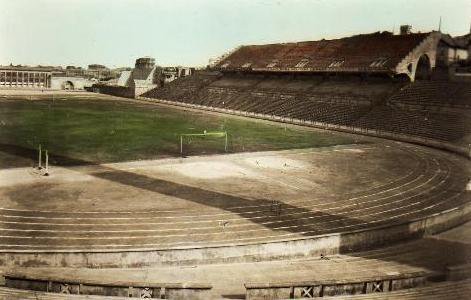
The stadium was used for an international when Spain played Portugal on 6 May 1945, a month that also saw Depor’s relegation to La Segunda. The final of the Copa del Generalísimo (Copa del Rey) paid its one and only visit to La Coruña in June 1947, when Real Madrid beat Espanyol 2-0 after extra time. The stadium remained unaltered for the next 30 or so years, except for the demolition of the arches at the eastern end in 1968, to make way the Palacio Deportes, the indoor sports arena that still stands today. At its peak, the Riazor had a maximum capacity of 45,000, but crowds of up to 60,000 were unofficially recorded.
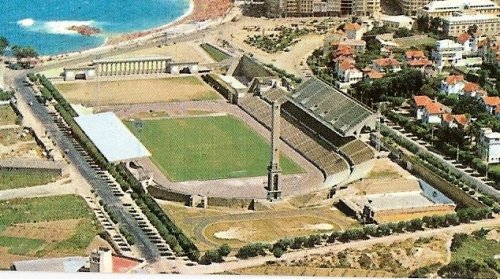
If you are wondering why I’ve not commented a great deal on Depo’s on-pitch activities, the reason is that they didn’t achieve a great deal apart from the second place in La Primera in 1949-50. In fact, they were the classic “elevator” team, losing and regaining their top-flight status on 8 occasions between 1942 and 1971. The elevator dropped a further “floor” in 1974 to the Tercera and once again in 1980 when Depor found themselves in Segunda B.
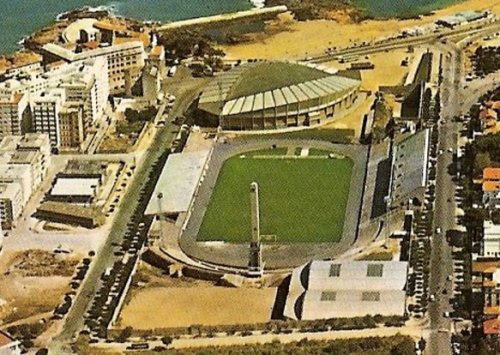
By the time of their second visit to Segunda B, work was underway preparing the stadium for the 1982 World Cup. This required almost total reconstruction and once again the municipality dipped into the public coffers and forked out over 80% of the 500 million pesetas bill. Two double-decker stands went up on either side of the pitch, whilst at the western end, two stands curved around the terrace, either side of the Marathon tower. All four roofs were identical in design and reflected Coruña’s maritime past, with sail-like roofs supported by cables that were moored to concrete posts behind the stand. Simon Inglis likened them to mooring ropes in his book The Football Grounds of Europe. For the duration of the tournament, the east end was left open, but following Deportivo’s return to La Segunda, temporary stands were erected at the eastern end of the ground for league matches, giving it a new capacity of 29,000.
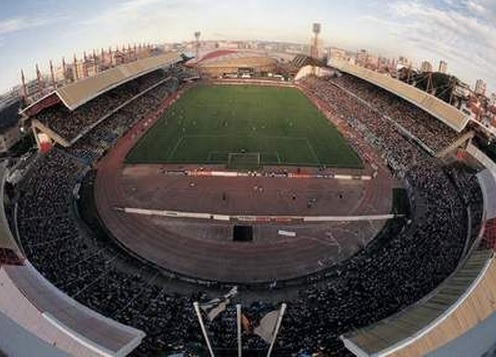
The Riazor staged three matches in the 1982 World Cup, involving Cameroon, Peru & Poland and shortly afterwards, Depor negotiated a 50 year deal with the municipality at a rate of 1 peseta per annum. The club had returned to La Segunda in 1981 and remained there for the next 10 seasons, before returning to La Primera in 1991 to embark on the most successful period in their history. Before they arrived back in the top tier, there was a spectacular and very nearly tragic day at the Riazor. Needing a win to secure promotion and with all the kick-offs synchronised, Depor’s match with Murcia was delayed due to a fire in the south stand. The Deportivo fans had been lighting flares, which in turn set light to the roof canopy. Unbelievably, the fire was contained and the match was only delayed by 48 minutes. Depor won 2-0 and promotion was secured.
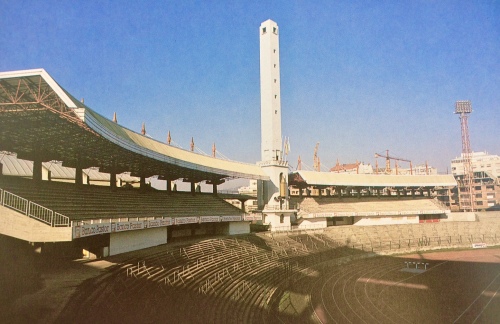
Three successive top-three finishes, including an agonising last-minute penalty miss that cost Depor the title in 1994, were matched by good results in Europe. Then in 1995, Depor won its first national trophy, lifting the Copa del Rey, but even then the manner of their win was peculiar. Playing Valencia at the Santiago Bernabéu, the clubs were drawing 1-1 with ten minutes to play. Then the heavens opened and the match was abandoned. The Spanish Federation ordered that the final 10 minutes should be played and three days later, everybody reassembled in Madrid expecting extra time. 58 seconds after the restart, Depor midfielder Alfredo headed in the winning goal and the trophy was heading to Galicia.
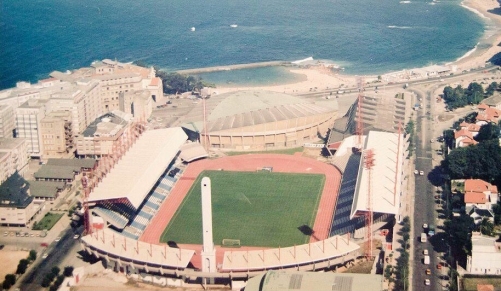
Despite being less than 15 years old, the layout of the Riazor was about to change again. Not satisfied with a 3-sided stadium and an athletics track between the stands and the pitch, the club and the municipality agreed to rebuild either end of the stadium and remove the athletics track. The maritime theme of the two side stands was continued with the new double-decker ends and the whole stadium was bedecked in bands of blue and white seats. The new layout had an all-seated capacity of 34,600, and all were filled when Real Madrid were the visitors for the first match in February 1998. Unfortunately, not all of the seats remained in place as local ultras, disenchanted at the loss of terracing, threw many onto the now nearby playing surface.
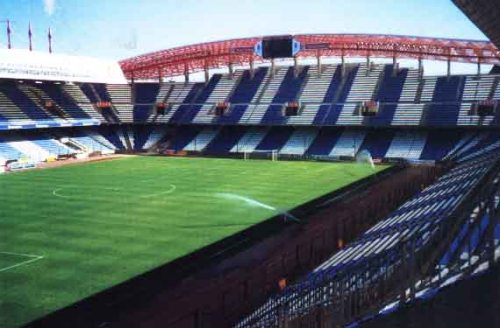
A little over two years later, disenchantment had made way for euphoria as Depor won their first and to date, only Primera title. Another Copa del Rey followed in 2002, and the stadium had all the trappings of a modern European stadium added, such as VIP lounges and large TV’s come scoreboards. However, pickings have been slim in the past few years, as appearances in the Champions League have dried up and so has the money. After a number of seasons flirting with relegation, the drop finally arrived in May 2011. To be frank, Depor had been many pundits pick for relegation from the start of the season, and whilst form picked up in the middle third of the season, their inability to score (just 31 goals all season) proved to be their downfall. After a shaky start to life back in the second division, Deportivo hit their stride, winning 18 of 20 matches in the middle of the season to establish them at the top of the league. Victories in both Galician derbies and the league title capped a successful season. Seemingly determined to recreate the era of Depor being an “elevator” team, relegation to La Segunda followed within 12 months, only for promotion to be gained back to the top flight in June 2014.

Time & salt air has taken its toll on the Riazor. The last remodelling of the stadium took place over 20 years ago, and the roof, in particular, was leaving spectators exposed to the elements. In June 2018 work started on a €16m project, the first phase of which was to replace the roof on all for sides of the stadium. This has been funded by the local council and the club, who sold naming rights in 2017 to the Abanca Group. The next phase will see the exterior of the stadium wrapped in a fashion similar to the work carried out at the Mestalla & Sánchez Pizjuán. As a modern football stadium the Riazor (Not the Abanca Riazor on these pages) works well and compared to most it has character. But if you are looking for real character, check out the history books… and our gallery!

1 thought on “La Coruña – Estadio de Riazor”